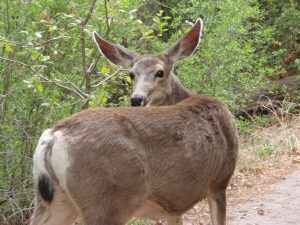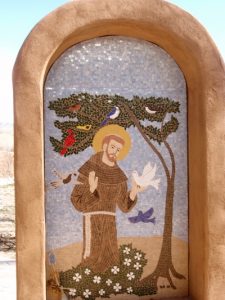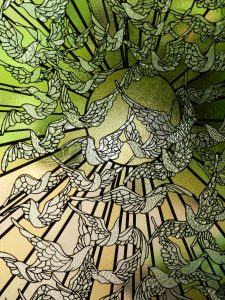 Happy Feastday! Has anyone extended this greeting to you today? I hope you will hear it at least once! After all, it is your feast, our feast, the feast of all the “little saints” here and gone before us. Oh, we are used to the “biggies” … the Peters and Pauls, the Matthew – Mark – Luke – and John quartet … Mary Magdalen, Elizabeth Ann Seton, Joan of Arc, and the list goes on and on. They have their own special feast days on our liturgical calendar. But what about us? Have you given a thought to your own grandparents, your Mom and Dad, your siblings who have gone before you? Do you think of them as saints? Do you think of yourself as a “Saint-in-the-making?” Today is a good day to take some time to celebrate them, their ongoing presence in your life. Today is a good day to celebrate us, saints on the way, doing our best to live a life of joyful service and compassionate grace. What will you do to celebrate today? Happy Feastday!
Happy Feastday! Has anyone extended this greeting to you today? I hope you will hear it at least once! After all, it is your feast, our feast, the feast of all the “little saints” here and gone before us. Oh, we are used to the “biggies” … the Peters and Pauls, the Matthew – Mark – Luke – and John quartet … Mary Magdalen, Elizabeth Ann Seton, Joan of Arc, and the list goes on and on. They have their own special feast days on our liturgical calendar. But what about us? Have you given a thought to your own grandparents, your Mom and Dad, your siblings who have gone before you? Do you think of them as saints? Do you think of yourself as a “Saint-in-the-making?” Today is a good day to take some time to celebrate them, their ongoing presence in your life. Today is a good day to celebrate us, saints on the way, doing our best to live a life of joyful service and compassionate grace. What will you do to celebrate today? Happy Feastday!
Light transforms an ordinary pumpkin into a jack-o-lantern. Similarly, the light of Christ transforms us ordinary people into saints. Who, after all, are the saints? They’re the people who let God’s light shine through in everything they do. We are privileged to carry the light of Christ within us. Do we let it shine?
Today be a jack-o-lantern. Let your light shine. Compliment the cashier or waitress. Pay it forward. Tell family members and friends how much you appreciate them. Be grateful for even the tiny things. Surprise someone with an act of kindness. It takes just a few minutes to transform a dismal autumn day into an experience of God’s goodness.
A heart-stopping moment: I was driving home from the Jesuit Center the other day when a large deer darted right in front of the car. Awesome!
A heart-expanding moment: I was praying Monday morning when I looked out across the newly harvested cornfield and witnessed a very BIG buck leap across the field, antlers held high. Awesome!
Two events, awesome in their own way. What is it about deer that lure us into observing creation with a more careful and contemplative eye?
So much of God’s creation we take for granted. As fall continues to unfold before our very eyes in the splendor and majesty of color … in the animals seeking food before winter approaches … in the whispers of wind and colder breezes … let’s be attentive. Look … listen … smell … taste … feel … in a word: SAVOR. Beauty is everywhere!
Halloween is coming, and many little people in our Catholic schools will dress as saints to celebrate All Saints Day on November 1. We’ll see a serene Therese of Lisieux, a Blessed Virgin Mary, and a Saint Joseph. Less often do we see the saints whose horrifying deaths were as gory as the latest movie. Saint Sebastian was shot through with arrows. Saint Francis of Assisi suffered the five wounds of Christ. Saint Lawrence was grilled over fire and supposedly joked, “Turn me over. I’m done on this side.” Saint Joan of Arc, too, was burned alive. Saint John the Baptist and Saint Paul were beheaded. Saint Ignatius of Antioch was fed to the lions. Saint Stephen was stoned to death, and Saint Isaac Jogues was killed by a tomahawk.
Sometimes we think of holiness as serene. We picture saints wrapped in contemplation, basking in God’s love. Certainly there were such times, but all of them—however they lived and died—were horribly good disciples of Jesus Christ.
There are more statues of this man than anyone else at El Santuario de Chimayó in the small village of Chimayó in northern New Mexico. He outstrips St. Therese of Lisieux and St. Francis of Assisi and even Our Lady of Guadalupe and Nuestro Señor de Esquipulas, in whose honor the pilgrimage site was created many, many years ago. Who is this man? None other than the one we celebrate this day in Catholic tradition: St. Jude. The one we give the name “patron of hopeless causes.” One of the obscure apostles who has left obscurity behind in popular Catholic piety. No other “saint” garners as many novenas as does St. Jude!
I have a special affinity for this Gospel fellow since I grew up in the parish of St. Jude in Toledo many moons ago. Though the church was officially closed a number of years ago, I’d like to think the spirit of that lively Catholic community lives on in those of us who were so privileged to be a part of this dynamic parish. Fond memories of feast day celebrations rose up as I prayed this morning: dress up days in green and gold (our St. Jude colors), chrysanthemums on the altar in greens and golds, processions, novenas, green and yellow frosted cupcakes for the occasion. All the things children would remember! The halcyon days of youth.
And today? Perhaps we need St. Jude more than ever. Amidst government shutdowns, health care glitches of major proportions, wars raging across the globe, ever ongoing violence in our schools, vast environmental degradation, poverty, hunger, abortion, you-name-it … who is the saint for our times? Maybe amidst the growing rise of uncertainty and disillusionment we need a saint who can help us walk through the minefield of hopelessness and fear. Maybe St. Jude needs to be more than a saint for personal hopeless causes. Maybe we need to ask him to walk with us collectively and globally.
And just maybe … WE need to BECOME the “Saint Judes” and “Saint Judiths” of today. Maybe WE need to stand up in the face of fear and hopelessness, and as Christians offer a word of truth … encouragement … comfort to those in despair. Maybe WE need to BECOME charity and justice, the “two-feet-of-love-in-action” as the very remedy for hopelessness in our world.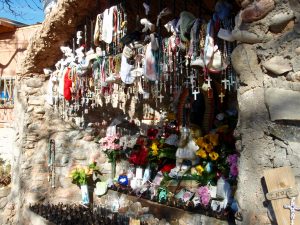
Indeed … on this day and every day: Saint Jude, pray for us!
Shakespeare’s comedies are near tragedies. The mix-ups and disguises, the twists of language, the intricate plot bring the audience to the brink of tragedy; however, something happens in the last act that changes course, and we receive that “happy-ever-after” feeling. The near tragedy becomes a comedy, often shown in an expression of community, such as a dance or actors staged in a circle.
The life of Jesus, too, was near tragedy. Everything pointed to crucifixion. On Good Friday tragedy prevailed, but Jesus Christ rose from the dead. He had the last laugh. Soldiers thought they had Jesus beaten? Ha-ha! The religious authorities thought Jesus was silenced? Ha-ha! Jerusalem would forget him? Ha-ha! Resurrection transforms the tragic ending into a comic beginning—like the Shakespearean comedy that ends in community. Now the Risen Christ is identified with all God’s People, and all God’s People are part of the Body of Christ. We, the community of Jesus Christ, have the last laugh.
 For this reason we carve jack-o-lanterns, symbols of the last laugh. Their smiling faces seem to say, “Death, you can’t scare me. I’m going to rise with Jesus Christ! Graveyards, you’re not scary. I’m going to rise with Jesus Christ! Skeletons, that’s not me. I’m in heaven!” As you see jack-o-lanterns this week, let them remind you of resurrection and community in Christ.
For this reason we carve jack-o-lanterns, symbols of the last laugh. Their smiling faces seem to say, “Death, you can’t scare me. I’m going to rise with Jesus Christ! Graveyards, you’re not scary. I’m going to rise with Jesus Christ! Skeletons, that’s not me. I’m in heaven!” As you see jack-o-lanterns this week, let them remind you of resurrection and community in Christ.
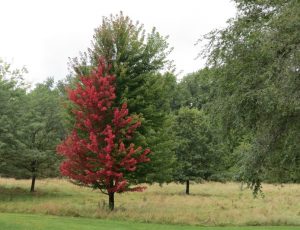 “Seeing how God works in nature can help us understand how He works in our lives,” Janette Oke claims. Surrounded by 95 acres of woods, lake and meadow I live up close and personal to nature. Sometimes nature is slow, like a long cold spring when summer weather is hardly in time for the Fourth of July picnic. Sometimes nature is very fast. Leaves turn red with the turning of the calendar to August. Nature can feel like feast or famine—grapevines bare one year and heavy another. Nature is mysterious with more species unknown than known. Constantly changing, ever surprising, sometimes interminably slow, other times unnaturally fast are nature and God’s work in our lives.
“Seeing how God works in nature can help us understand how He works in our lives,” Janette Oke claims. Surrounded by 95 acres of woods, lake and meadow I live up close and personal to nature. Sometimes nature is slow, like a long cold spring when summer weather is hardly in time for the Fourth of July picnic. Sometimes nature is very fast. Leaves turn red with the turning of the calendar to August. Nature can feel like feast or famine—grapevines bare one year and heavy another. Nature is mysterious with more species unknown than known. Constantly changing, ever surprising, sometimes interminably slow, other times unnaturally fast are nature and God’s work in our lives.
How is God slow in your life? How is God fast? Is God more like feast or famine? Do you want God to be mysterious or well-known?
Take some time to observe nature, and then observe God’s work in your life.
 I like tables. I like to do my paper work on a table, spreading out an array of paper, pens, markers, and a cup of coffee. I like kitchen tables with their feeling of at-home-ness. One of my favorite times of the day is to sit down at the dining room table with four other Sisters of Notre Dame in my small community in Whitehouse, Ohio. The Sister whose turn it is to make dinner sets down the bowls, as the steam rises, and our eyes take in the spread before their cast down in meal prayer. Convent meals are usually rather ordinary, and our talk encompasses the day’s activities, world events, or the cute things little ones say at school. Much of my ordinary day occurs at tables—wiping them clean, writing, eating, talking, or playing a card game. I believe with Macrina Wiederkehr in “the incredible gift of the ordinary! Glory comes streaming from the table of daily life!”
I like tables. I like to do my paper work on a table, spreading out an array of paper, pens, markers, and a cup of coffee. I like kitchen tables with their feeling of at-home-ness. One of my favorite times of the day is to sit down at the dining room table with four other Sisters of Notre Dame in my small community in Whitehouse, Ohio. The Sister whose turn it is to make dinner sets down the bowls, as the steam rises, and our eyes take in the spread before their cast down in meal prayer. Convent meals are usually rather ordinary, and our talk encompasses the day’s activities, world events, or the cute things little ones say at school. Much of my ordinary day occurs at tables—wiping them clean, writing, eating, talking, or playing a card game. I believe with Macrina Wiederkehr in “the incredible gift of the ordinary! Glory comes streaming from the table of daily life!”
Life is the table at which we sit. What do you do when you’re sitting there? Let incredible things happen.
 Genes, chromosomes, DNA, everything that makes me Me is mystifying and truly awesome. Out of the millions of possibilities, God made Me. But God didn’t step back to admire the creation. Instead God became part of my every cell–not in a pantheistic way, but in they way of Scripture: “In him we live and move and have our being” (Acts 17:28).
Genes, chromosomes, DNA, everything that makes me Me is mystifying and truly awesome. Out of the millions of possibilities, God made Me. But God didn’t step back to admire the creation. Instead God became part of my every cell–not in a pantheistic way, but in they way of Scripture: “In him we live and move and have our being” (Acts 17:28).
Today live and move and enjoy your being in God.
Every saint is a facet of the Diamond who is God. And every saint who has founded a religious congregation has given that facet to his or her followers. We call that facet a charism, meaning a gift to the world. A charism is the way a particular person or group follows Jesus Christ, thus incarnating Christ in our world today. The facet of the Diamond God who was Francis was joy and freedom in following the Gospel strictly by seeking out the poor and sick and freely vowing poverty and nonviolence. Francis’ charism turned worldly values upside down.
Almost 800 years later Pope Francis is turning values upside down. He, too, is a man of joy and freedom. Let us pray for Pope Francis today, as well as all Franciscans. And let us consider our own charism. What is your gift to the world? What facet of the Diamond God are you? (credit for this post goes to Sr. Mary Valerie Schneider, SND)



